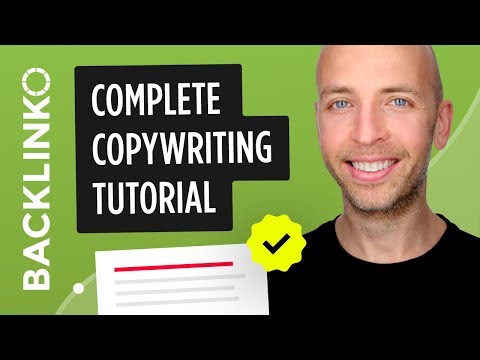In this post, you’ll learn how to use SEO Copywriting to create a piece of content that will drive sales and leads. We’ll give you our best advice and tools to assist you in your journey to produce high-quality content that helps your search engine optimization.

If you’re one of the 81 % of Internet users aged 16 to 64 who begin by logging onto your favorite search engine and entering a search query, you will already know how important search engine rankings can be to get qualified traffic to your websites.
Search engines such as Google are now an integral element of today’s consumer buying decision-making process, making it crucial for marketers to focus on SEO optimization in their digital marketing strategies. SEO copywriting is a crucial element of this optimization.
Knowing the fundamentals of SEO Copywriting means, the best way to effectively do it and what tools can you use to write quality content at size will allow you to increase your rankings on search engines and generate sales and leads through organic traffic. You will need help with finding competitive keywords and the right search term that your targeted audience is looking for when they use a search engine. You will also need to calculate keyword density for your compelling content, making sure to stay within suggested guidelines.
What Exactly Is SEO Copywriting?
SEO copywriting is the practice of writing marketing copywriting specifically designed for SEO. The type of copywriting used is intended to be appealing to humans as well as algorithms for search engines in the hope of driving organic traffic to a business’s website and enabling the traffic to turn into prospects or even sales.
When writing SEO copywriting, the author has to optimize the content to be indexed by search engines. The search engines determine the subject matter of the article and present it to the correct people. It’s crucial that the author creates this content for the reader’s eyes since the main goal is to encourage the reader to purchase.
Copy that’s written just specifically for search engines may not be appealing to readers or possess the same quality of reading as copy written for human readers. Although copy written for the user might not include the necessary keywords to aid in ranking on Google search, professional SEO copywriters are able to achieve an incredibly balanced balance between both.
SEO Copywriting And SEO Content Writing: What’s The Difference?

The primary distinction of SEO copywriting from SEO content writing lies in the objective of content. While SEO copywriting has the main objective of turning organic traffic into leads and sales, SEO content writers’ primary goals are focused on the generation of organic traffic through search engines. They are more concerned with understanding search engine algorithms and how they can affect the flow of traffic to your website.
Copywriters and writers share the same set of skills and often the same person can be able to write both kinds. However, choosing to hire an SEO content writer when you are planning to hire an SEO copywriter will affect the way you achieve the goal of generating sales and leads.
Both copy and content can generate organic traffic and generate sales and will form integral parts of your content marketing and SEO Content Strategy.
However, knowing the distinction between them and how to make the most of both is crucial in the development of your strategy for marketing through content.
5 SEO Copywriting Strategies For The Best Results
SEO may seem to be a bit confusing to those who are not used to SEO copywriting. Here are five suggestions you can follow to begin and prepare yourself to be successful:
1. Do your keyword research
Keyword research is usually the initial step to develop and the implementation of the SEO strategy. It’s an intricate process, but it is possible to use tools to make it easier.
For the first step in your research on keywords, you should make an outline of the search phrases you believe your intended audience will be using to locate your products or services on the internet. Keywords need not be a single word. It is also important to include long-tail keywords as well as queries in your first keyword list to help with content creation.

A long-tail keyword will be easier to rank for as it usually has less competition but you will need to avoid Keyword stuffing as that no longer works and usually will attract a penalty. Google doesn’t like a content marketer trying to cheat their process by adding a long list of keywords to their online content. They are looking for content pieces that answer questions and so you should remember to write Content for People and not the search engines at all times.
Be aware of the intent behind your search when conducting your research on keywords. For instance, people who are just beginning to investigate their issue might be looking for informational purposes that is, they are searching for details. In contrast, whereas “what is SEO” is an informational intention, “hire SEO expert” has a business-related intent that means the person is likely to be in the market to buy.
2. Improve your heading and tagline
Another aspect of SEO that affects the rank factor is the metadata you provide to Google. Your metadata for your webpage is data that Google analyzes to understand the goal of your site and the type of content it contains. This way Google can ensure that it is delivering only the most interesting and relevant content to users. The SEO copywriting process needs to balance the ultimate goal of getting a better ranking in the search engine search results with providing original content that both informs and entertains, this will also help improve your website’s bounce rates and keep potential customers coming back for more.
Metadata is comprised of the header tag, your title tag, and meta description for every page. The header tag (or H1) is similar to the subject line for your page. The title tag informs search engines exactly what the page’s content is. The meta description is not as important in ranking, it is crucial in getting people to click your website via your search results. So using your focus keyword and other related variations of the primary keyword will help here.
Below are some SEO top practices in regard to metadata:
- The title tag should have 55 characters or less , and should include the phrase or keywords.
- Meta descriptions must be written in a convincing manner and contain the keyword or phrases that describe the content.
- The length of Meta description should be 150 to 160 characters and it should not contain quotation marks or other non-alpha characters since Google will erase these.
- The best practice is to include your target keyword in the H1 tag at the start of your header.
- Use H2 tags if you know there are many sections in your content. For instance, you could apply H1 to the title and H2 to describe the subheadings in the text.
- Beware of duplicate headers, titles or meta-descriptions.
3. Copywriting that incorporates keywords naturally

It’s crucial to include the right keywords within your SEO copy since it helps search engines comprehend the content you write about to ensure that they deliver the right audience in your direction. If you’ve used keyword research tools to put together an effective keyword strategy, this is where it will leap into action.
But, if you’re looking to increase leads and the sale (which is the aim of SEO copywriting) You need to be sure to create your content with a style that can encourage users to take action when they are on your page. Conversion rate optimization includes more than just writing seductive content, but it is your main focus as a copywriter.
This means that you must be focused on quality and readability when writing content, and not just the keywords. Make sure to use the keywords naturally throughout your blog content, but don’t attempt to cram them into paragraphs or sentences where they don’t fit. It’s ultimately the user who is buying, therefore the content must be able to make sense to them. The content structure needs to inform and entertain as well as help boost your organic rankings. Stringing together keyword phrases just for the sake of including them is not good keyword usage, instead learn how to create informational content that uses keywords naturally.
4. Include CTAs (CTAs)
The purpose in SEO copywriting is to create sales and leads. This is why it’s crucial that you incorporate a call to action inside your text. (You might need multiple CTA!) The call-to-action will assist readers in taking follow-up, which is to be an affiliate or purchase some product from you.

The text for the call-to-action must be clear, specific, and actionable to ensure that the user knows what you want them to do in the next step. For example, instead of the typical “contact us for more information” CTA, you might include, “Email our onboarding team to begin.”
It is also important to include a link that leads users to the next stage of the CTA. HubSpot discovered the anchor text CTAs or CTAs which were linked to a different website, increased conversion rates by 121%. If you make it simple for your customers to move on to the next step of the funnel, they’ll be more inclined to follow through with it.
5. Include external and internal links
Another crucial aspect to optimize your SEO on your website is hyperlinking. Search engines love to see that you are linking to quality content in other sites (external hyperlinks) and also appropriate pages that are on your site (incoming links). This tells Google that you’re giving searchers a wealth of useful information.
The more details you include on your website the more likely you will receive backlinks from different websites to your website that will increase the chances of being ranked on the search results page (SERP). Link building takes time however, the higher quality websites which link back to your site the more valuable they are.
You should only hyperlink to websites that provide quality, relevant, and correct information. Also, ensure that the external links are opened in a separate browser tab to prevent distracting your reader from your content.
3. SEO Copywriting Tools That You Must Have To Cut Down On Time
Are you looking to cut down on time and energy in writing SEO-friendly copy? Here are three SEO tools you can utilize for taking your SEO optimization to the next step without making your life more difficult:
1. Jarvis.ai
The other tools listed on this list focus on helping you discover keywords and optimizing the copy that you’ve written already, Jarvis handles all the SEO content writing on your behalf. To begin using the AI-powered writing tool select any of the Jarvis templates that cover everything including Google and Facebook advertisements to blog posts and product descriptions.

Once you’ve picked the template, Jarvis will guide you through the steps of what you should input into the tool to create an efficient document. If you’re using Boss Mode, you’re able to write SEO copy fast by employing multiple copywriting abilities within an identical document. For instance, you can make use of Jarvis for creating a product page using the program to write a product’s description along with sub-headers and persuasive bullet points – all within the same document!
You can also utilize Surfer as well as Jarvis together to create or rank your blog post more quickly this is a great method to increase SEO content on your website, so you can begin driving higher organic visitors.
2. Surfer
Surfer’s a powerful SEO tool that provides many features that assist you in planning, creating, and enhancing your SEO content. The editor of content reviews and evaluates your content live providing suggestions for how to improve it. The content planner will help to develop a strategy for your content by providing you with relevant keywords and topics within a matter of minutes.
Surfer excels thanks to its keyword analysis feature. It lets you find words that appear in the same search results on Google to find new keywords to target. If, for instance, you discover that a competitor is being ranked for three different keywords, there’s a high possibility that you’ll be capable of ranking for all three keywords as well.
With Surfer it is possible to type your search terms into the tool and get suggestions for phrases and keywords relevant to your search. Additionally, you can find real inquiries that people type in the Google search bar, which allows you to align your keywords phrases to the searcher’s purpose.
3. BuzzSumo
BuzzSumo is a fantastic tool to find trends and topics in your field. It will show you which topics and content are trending and coming up. The information you gather will help you to find new trends and topics that you can write about in order to benefit from the attention to the current content.
BuzzSumo examines billions of articles along with social media postings, giving you the most accurate information on what is most popular in your field. In addition to seeing the most popular articles that are well-known online as well, you’ll be able to view the most popular posts from your competition. You can also look through the last five years of data on the performance of your content to determine which subjects are more popular.
4. Menterprise
Menterprise offers a user-friendly end-to-end content creation tool that allows you to generate multiple articles, complete with embedded videos and photos, in just a few clicks. If you’re planning on running a multi-pronged content marketing campaign, Menterprise can help you come up with on-demand content that is optimized for ranking on SERPs.
You can target any keyword or niche and create a set of articles and blogs that you can further customize and optimize to organically reach your target audiences without having to spend too much time on keyword research and data analysis. The app does all the work for you, its algorithm allows it to mix and match all the relevant pieces of data it has on a topic to churn out unique content for your campaigns.
Conclusion
Modern SEO Copywriting has seen the introduction of a new SEO copywriting strategy. The goal is now to balance high click-through rates with creating content that attracts the ideal customer to your website in the first place and then to sign up to your email list before clicking through to become a new customer.
Online marketers should already appreciate the value of experienced copywriters. If you are lucky enough to find one then make sure to make them an integral part of your Marketing Team.






